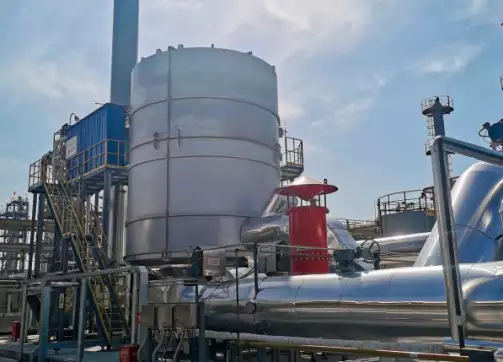What are the emissions from an RTO in air pollution control?
Introduction
Regenerative Thermal Oxidizers (RTOs) are a type of air pollution control technology used for the destruction of volatile organic compounds (VOCs) and hazardous air pollutants (HAPs) from industrial processes. This article will discuss the emissions from an RTO in air pollution control.
What is an RTO?
An RTO is a type of air pollution control equipment that uses high temperatures to oxidize pollutants in the exhaust air. RTOs are often used in industries such as pharmaceutical, chemical, and food processing to destroy VOCs and HAPs.
How does an RTO work?
The RTO works by preheating the incoming exhaust air in a heat exchanger. The preheated air is then directed to a combustion chamber where it is ignited with natural gas or propane. The hot gases from the combustion chamber flow through a ceramic media bed, which absorbs the heat. The hot ceramic bed is then used to preheat the incoming exhaust air, completing the cycle.
Emissions from an RTO
While RTOs are highly effective at destroying pollutants, they also produce emissions. The primary emissions from an RTO include carbon dioxide (CO2), nitrogen oxides (NOx), and trace amounts of hazardous air pollutants (HAPs).
Carbon dioxide emissions
The combustion of natural gas or propane in the RTO produces CO2, a greenhouse gas that contributes to climate change. However, the CO2 emissions from an RTO are relatively low compared to other types of air pollution control equipment.
Nitrogen oxide emissions
The high temperatures in the RTO can cause the nitrogen and oxygen molecules in the incoming air to react, forming NOx. NOx is a respiratory irritant and can contribute to the formation of smog.
Hazardous air pollutant emissions
Trace amounts of HAPs may also be emitted from the RTO, depending on the type of pollutants being destroyed and the operating conditions of the system. However, the emissions of HAPs from an RTO are much lower than the emissions from other types of air pollution control equipment.
Conclusion
RTOs are highly effective at destroying VOCs and HAPs, but they also produce emissions. The primary emissions from an RTO are CO2, NOx, and trace amounts of HAPs. While these emissions are relatively low compared to other types of air pollution control equipment, it is important to monitor and minimize emissions to protect air quality and human health.
Company Introduction
Our company is a high-end equipment manufacturing enterprise specializing in comprehensive control of volatile organic compounds (VOCs) emissions and carbon reduction energy-saving technology. We have four core technologies: thermal energy, combustion, sealing, and automation control. Additionally, we possess capabilities in temperature field simulation, air flow field simulation modeling, ceramic heat storage material performance, selection of zeolite molecular sieve adsorbents, and high-temperature incineration and oxidation testing of VOCs. We have a RTO technology research and development center and an exhaust gas carbon reduction engineering technology center in Xi’an, as well as a 30,000 square meter production base in Yangling. We are a leading manufacturer of RTO devices and zeolite molecular sieve rotating wheel equipment globally. Our core technical team comes from the Aerospace Liquid Rocket Engine Research Institute. We currently have more than 360 employees, including over 60 R&D technical backbones, three senior engineers with the title of research fellows, six senior engineers, and 47 thermodynamics PhDs.
Core Products
Our core products include the Rotary Valve Regenerative Thermal Oxidizer (RTO) and the zeolite molecular sieve adsorption and concentration wheel. With our expertise in environmental protection and thermal energy system engineering, we can provide customers with comprehensive solutions for industrial waste gas control, carbon reduction, and thermal energy utilization under various operating conditions.
Certifications, Patents, and Honors
- Certifikace systému správy duševního vlastnictví
- Certifikace systému managementu jakosti
- Certifikace systému environmentálního managementu
- Construction Industry Enterprise Qualification
- High-tech Enterprise
- Patents for Rotary Valve Regenerative Thermal Oxidizer
- Patents for Rotary Wheel Heat Storage Incineration Equipment
- Patents for Disc Zeolite Rotating Wheel

How to Choose the Right RTO Equipment
- Determine the characteristics of the exhaust gas
- Understand local regulations and emission standards
- Vyhodnoťte energetickou účinnost
- Zvažte provoz a údržbu
- Analyze budget and costs
- Vyberte vhodný typ RTO
- Zvažte environmentální a bezpečnostní faktory
- Perform performance testing and verification

RTO Air Pollution Control Service Process
- Preliminary consultation, on-site inspection, and needs analysis
- Solution design, simulation modeling, and solution review
- Zakázková výroba, kontrola kvality a tovární testování
- Instalace, uvedení do provozu a školení na místě
- Pravidelná údržba, technická podpora a dodávky náhradních dílů
We provide a one-stop solution for RTO air pollution control, with a professional team that tailors RTO solutions to meet the specific needs of our customers.
Autor: Miya
